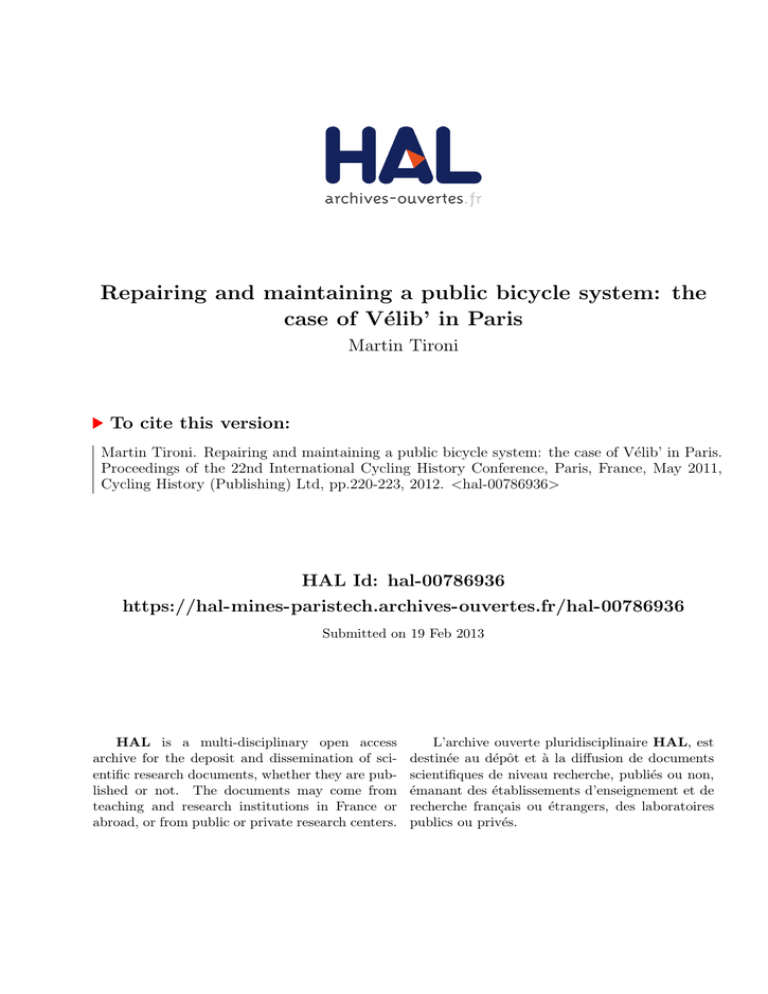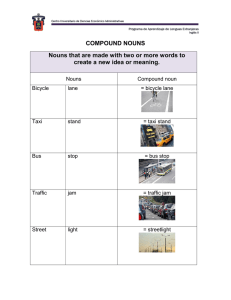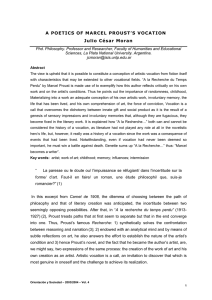Repairing and maintaining a public bicycle system: the - Hal-SHS
Anuncio

Repairing and maintaining a public bicycle system: the case of Vélib’ in Paris Martin Tironi To cite this version: Martin Tironi. Repairing and maintaining a public bicycle system: the case of Vélib’ in Paris. Proceedings of the 22nd International Cycling History Conference, Paris, France, May 2011, Cycling History (Publishing) Ltd, pp.220-223, 2012. <hal-00786936> HAL Id: hal-00786936 https://hal-mines-paristech.archives-ouvertes.fr/hal-00786936 Submitted on 19 Feb 2013 HAL is a multi-disciplinary open access archive for the deposit and dissemination of scientific research documents, whether they are published or not. The documents may come from teaching and research institutions in France or abroad, or from public or private research centers. L’archive ouverte pluridisciplinaire HAL, est destinée au dépôt et à la diffusion de documents scientifiques de niveau recherche, publiés ou non, émanant des établissements d’enseignement et de recherche français ou étrangers, des laboratoires publics ou privés. Repairing and maintaining a public bicycle system: the case of Vélib' in Paris1. Martin Tironi Phd candidate, Centre de Sociologie de l’Innovation, Mines ParisTech martin-tironi@mines-paristech.fr Introduction « Tous les êtres doivent s’instaurer, l’âme aussi bien que Dieu, l’œuvre aussi bien que la physique. Aucun être n’a de substance ; s’ils subsistent, c’est qu’ils sont instaurés » Bruno Latour, 2009a. Valued for their 'planet friendly' character, public bicycle systems have become the hallmark for cities that want to become part of the so-called 'green culture'. Sustainable city, new technologies, new mobility, public and individual transport: these, amongst others, are the terms usually used to refer to the worldwide spread of public bicycle schemes (PBS). They now exist in more than 110 cities around the world (including Vienna, Berlin, Brussels, Seville, Dublin, Barcelona, Paris, Rome, Rio de Janeiro, etc.). Buenos Aires and London are the most recent cities to set up programmes of this type with London’s Cycle Hire system being the model, and projects of the same ilk are on their way in cities like New York and Sydney. These technologies are based on the principle of fixed docking stations scattered around the city, where users can pick up or drop off the bicycles using a smart membership card, which is either rechargeable or linked to their bank account. Paris’ Vélib’ program, which is managed by the multinational JCDecaux company, is the largest system of its kind in the world, with 1800 stations and 20,600 bicycles (Fig. 1). Every year Paris City Hall, receives delegations from different countries seeking to study the operation of this large-scale infrastructure. The scheme has been successfully extended to certain areas in the outskirts of the city (Plaine Commune, Créteil, Cergy Pontoise), and it employs more than 400 technicians and service personnel. According to surveys conducted in 2009, satisfaction with the scheme stands at 96%, 46% of users claim to use their cars less frequently, and 18% say that because of Vélib’ they have gone places where they had never been before! 1 Reference : Tironi, M. (2012). « Repairing and Maintaining a Public Bicycle System: The Case of Velib' in Paris » in Cycle History - 22. Cycle History (Publishing), Ltd., UK. Fig. 1 : The day of release of Vélib’ program Marc Augé, dedicated one of his recent works (Éloge de la bicyclette, 2007) to a description of the Vélib’ operation in Paris, pointing out the transformations it is bringing about in the life of the city. In his pursuit of the benefits of identifying the new practices associated with the new mobile infrastructures, the ethnologist states that – against the background of the grey and noisy urbanism that threatens to reduce the territory of Paris to a mere facade, a gigantic setting for tourists – the new public bicycle system represents a chance to recapture the free experience of the city and to restore the natural appearance it demands. The intention of this short paper is to analyze the Vélib’ system from a different perspective than the one set forth by Marc Augé by considering an often ignored, but essential dimension on the subject: ‘the invisible work’ which about 400 agents working in the system do on a daily basis to maintain the functioning of this sustainable mobility program. As it has been demonstrated by different authors (Orr, 1996 ; Graham and Thrift, 2007 and Dennis and Pontille, 2010 ; Dant, 2010), all forms of social order (ranging from conversational interaction to the presentation of a transport system) require constant repair and maintenance operations. Graham & Thrift (2007, p. 6) stress this aspect when they say « the world is involved in a continuous dying that can only be fended off by constant repair and maintenance ». Through the description of the knowledge and the know-how mobilized by the systems agents, it will be shown how these actors, through their daily contact with the city and users, become real « sociologists of mobility ». This is accomplished by drawing on interviews and ethnographic observations made by technicians in the field that are involved with the program. The Agents of Maintenance are « Sociologists of Mobility » The pre-established functions of maintenance agents are repairing and maintaining the bicycles in the field (Fig. 2) and the stations’ interactive systems (Fig. 3). They must be able to repair and perform maintenance on as many bicycles as possible on the street. The bicycles which have more serious problems and cannot be repaired on the street are identified (and blocked from further use) and then sent to repair shops to be dealt with by mechanics. These agents describe bicycle breakdowns as a constant struggle to detect problems and faults before the users ride broken bicycles and cause greater damage to the system. Fig 2. Fig 3. However, it is important to realize that in addition to their primary responsibility for maintaining the bicycles in the system, the maintenance agents perform another critical function by interacting with the service users on a daily basis (Fig. 4 & 5). As a result of this interaction, the maintenance agents have first-hand knowledge of user needs and their habits and their problems with the bicycles and stations. As one of these agents stated: Since we work out on the street, people are always asking us questions. People ask you all kinds of things about Vélib’, how to pay, information on addresses, etc. There are times when I can’t get my job done in peace because I’m constantly answering customers’ questions. Once, someone asked me to fix their personal bicycle. Therefore, maintenance agents are not in the field only to maintain the Vélib’ programme’s material setting (by repairing wheels, brakes, etc.), but also to maintain, and to repair as might be required, the « social » universe which exists around the entire system. Fig. 4 : agent talking with a user They contribute to the programme’s existence on a technical level, but beyond that they bring the system to life on a social level, by helping users and non-users solve minor problems. Hence, maintenance is actually about providing socio-technical stability for the programme, since the material repairs cannot be separated from the social care-taking performed by the agents. Maintenance agents contribute to a better technical and social integration of the system within the city of Paris. Fig. 5 Furthermore, the close relationship between agents and users has led agents to develop an insightful understanding of the systems users and customers. Agents are thus able to identify user “profiles”, different types of use of the service according to neighbourhoods and types of trips. As an example, an agent has provided a socio-spatial analysis of the problem of vandalism: The kind of damage caused to the bicycles is quite different in the north and in the south of Paris. In the north of Paris there are problems of deliberate vandalism, wheels punctured with knives, twisted frames, etc. On the contrary, in the centre of Paris there is less damage because there is usually more use, so people are afraid to vandalise, since the people who break the bicycles usually aren’t users. In this context, agents have become real « sociologists of mobility » and of the users. Their knowledge of the users is not abstract, but rather it is concrete, experiential knowledge, which leads them to develop crucial interpretations for the functioning of the Vélib’ system. This is combined with their excellent capacity to imagine solutions as problems arise. As has been said by Graham & Thrift (2007, p. 4), « improvisation allows the work of maintenance and repair to go on when things may seem bleak ». These agents’ main asset is their knowledge of the field, their constant and daily grappling with street problems, and this is being increasingly acknowledged by the managing company JCDecaux. This puts the conventional notion of « experts » into perspective, and as Richard Sennet (2008) suggests in The Craftsman, an expert is not just someone who gains knowledge through university degrees, but also someone who gains skills thanks to his/her experience. For maintenance agents in a pubic bicycle system, the urban ecology is a field for exploration and experiment, a space inhabited by uncertainty which requires a diversity of instruments and practices to maintain in good operational condition at all times, and to provide the service desired by users of the system. Final thoughts The universe of mobility created by Vélib’s public bicycle service, with its thousands of users and stations throughout the City of Paris, is constantly undergoing maintenance and repairs. The system’s ability to provide mobility for users is dependent on the systems infrastructure, its stationary facilities, the operation and dependability of its bicycles, and the competences (mechanical and sociological) of its staff. Thus, studying the Vélib system’s maintenance program brings us closer to understanding the « motionless requirements of mobility », i.e. the types of employee skills and the physical facilities required for providing useful, desirable and reliable mobility for users. Mobility is not a given capacity or competence, it cannot be considered a priori (taken for granted), rather it demands constant construction, learning, repairing and updating (Graham & Thrift, 2002; Latour & Hermant, 1998, 2009b). As public bicycle schemes are going global, the importance of, and the need for, studying the conditions and concrete skills which facilitate the integration of these technologies into city ecologies is clear. References. Amin, A. & Thrift, N. (2002). Cities, Reimagining the Urban. Londres: Polity Press. Augé, M. (2008). Eloge de la bicyclette. Paris : Payot. Dennis J. & Pontlle D. (2010). Petite sociologie de la signalétique. Les coulisses des panneaux du métro. Presses École des Mines de Paris. Dant, T. (2010). The work of repair: Gesture, emotion and sensual knowledge. Sociological Research Online, 15(3), 7. Graham, S. & Thrift, N., (2007). Out of Order. Understanding Repair and Maintenance!, Theory, Culture & Society, vol. 24(3), p. 1-25. Latour B., & Hermant É. (1998). Paris ville invisible. Paris : Les empêcheurs de penser en rond /La Découverte. Latour, B. (2009a). Sur un livre d’Etienne Souriau: Les Différents modes d’existence. en ligne: www. bruno-latour. fr/articles/article/98-SOURIAU. pdf. Latour, B., (2009b). Les moteurs immobiles de la mobilité. In De l'histoires des transports à l’histoire de la mobilité. Flonneau M. and Guigueno V. (Eds.), Rennes: Presse Universitaire de Rennes. Sennet, R. (2008). The Craftsman, Yale Unibersity Press. Orr, J. (1996). Talking about Machines: Ethnography of a Modern Job. Ithaca, NY:Cornell University Press. Tironi, M. (2013). Faire ciurculer des vélos et des personés. L’écologie urbaine et maintenance du programme Vélib’ de Paris. Revue d'anthropologie des connaissances. (Forthcoming)







